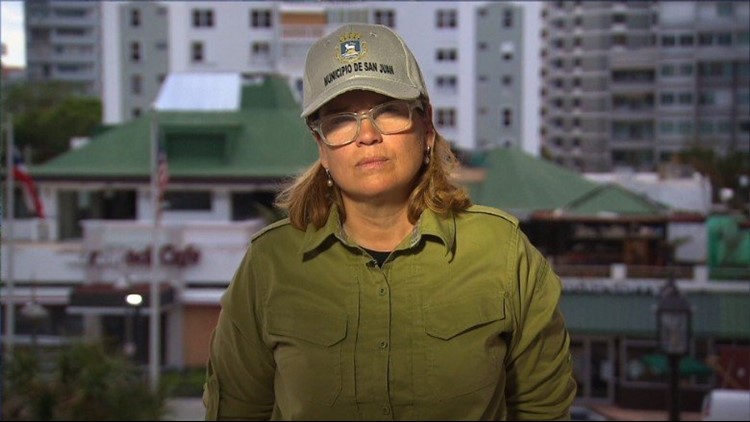Nearly three weeks after Hurricane Maria pummeled Puerto Rico, the vast majority of the island remains without power and the death toll from the storm has risen to 45, authorities said.
At least 113 people remain unaccounted for, according to Karixia Ortiz, a spokeswoman for Puerto Rico’s Department of Public Safety.
The recovery has moved slowly since Maria struck the US territory on September 20, leaving most of the island without basic services such as power and running water, according to residents, relief workers and local elected officials.
Acting US Department of Homeland Security Elaine Duke will make her second trip to the island on Thursday, DHS spokesman David Lapan said Wednesday.
The visit comes as hospitals throughout the cash-strapped island of 3.4 million people have been running low on medicine and fuel. Some residents and local elected officials have said they expect the death toll to rise.
In the town of Caguas, in the central mountain range, some patients — including one breathing with the aid of a ventilator — had to be evacuated to the Navy hospital ship USNS Comfort near San Juan after a generator failed, Dr. Christian Rodriguez said this week.
At least two people have died from leptospirosis, which spreads when the urine of infected animals gets into drinking water, San Juan Mayor Carmen Yulín Cruz told CNN Wednesday. People have been drinking water from creeks contaminated by dead animals, she said.
“We’re not out of the woods yet,” she said. “We are now starting to see a lot of health issues. … So we are in a great effort, a great humanitarian effort.”
As of Wednesday 89% of the island was without electricity and almost 47% had no phone service, according to a website set up by the Puerto Rican government. Some 43% of the island’s 313 bank branches remained closed, it said.
“We are making progress,” Chris Krebs, Homeland Security’s assistant secretary for infrastructure protection, said Wednesday. “There’s progress on the power side. But we can do more. We can push more resources down into the island.”
The recovery will take time given the storm’s magnitude, he said
“We are pushing everything we can down into Puerto Rico,” Krebs said.
“There are over 17,000 responders, whether it’s military or civilian assets. Over 100 helicopters doing air drops in remote communities, providing water. Each of the 78 municipalities has a dedicated water truck. Another 72 trucks are dedicated to hospitals and other critical services. … Over 50 generators have been installed in critical facilities not just heath care but also now moving into other facilities like schools.”
In the mountainous town of Añasco on the western coast, Lucelenia Rivera said she has been running a generator to keep her medications refrigerated but diesel fuel is in short supply. She suffers from asthma and arthritis, takes medication for her blood pressure and worries that recurring mudslides will further isolate her community.
“I’m going crazy trying to get out of here because of my physical condition,” she said. “But this is all I have. I don’t have money or another home. This is it.”
At least five of those who are missing lived in the northern coastal town of Arecibo, where residents have been lining up for hours to buy ice and fuel.
Some arrive as early as 1 a.m. at ice plants that won’t open for another six hours for a chance to buy a single bag of ice at a 20% markup, according to residents.
Kelly Lopez cried while saying she was denied an extra bag of ice for her sister, who is epileptic and bedridden.
“This is so hard on all Puerto Ricans,” she said.
For weeks, island residents have been queuing up in seemingly interminable lines for their basic needs — from food to cash.
Abisain Medina said he drove 30 minutes to Arecibo to stand in line at a bank for five hours before the bank’s computer’s crashed.
Puerto Rico Gov. Ricardo Rosselló, citing an “unprecedented catastrophe,” has lobbied Capitol Hill for a significant new influx of money soon as the island perches on the brink of “a massive liquidity crisis,” according to a letter obtained by CNN.
In a three-page letter sent to congressional leaders, Rosselló is requesting more than $4 billion from various agencies and loan programs to “meet the immediate emergency needs of Puerto Rico.”
The Trump administration submitted a $29 billion disaster-relief request to Congress last week to fund recovery efforts in the wake of hurricanes Harvey, Maria and Irma and to pay federal flood insurance claims. The House is expected to vote on that measure as soon as this week.
Rosselló also pointed to a potential exodus of the island’s inhabitants should aid not be available in a timely manner — something he has also emphasized in conversations with lawmakers.
Over 400,000 Puerto Ricans have moved to the mainland United States since 2004, according to the Pew Research Center. Puerto Rico now has 3.4 million residents.
Many left because Puerto Rico suffers from high unemployment, rising taxes and few job opportunities outside of tourism.



